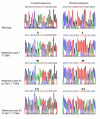Preponderance of the oncogenic V599E and V599K mutations in B-raf kinase domain is enhanced in melanoma cutaneous/subcutaneous metastases
- PMID: 15935100
- PMCID: PMC1164406
- DOI: 10.1186/1471-2407-5-58
Preponderance of the oncogenic V599E and V599K mutations in B-raf kinase domain is enhanced in melanoma cutaneous/subcutaneous metastases
Abstract
Background: Downstream of Ras, the serine/threonine kinase B-raf has been reported to be mutated, among other carcinomas, in a substantial subset of primary melanomas with a preponderance of mutations within the kinase domain including the activating V599E and V599K transitions.
Methods: We here investigated a representative series of 60 resection specimens of cutaneous and subcutaneous melanoma metastases for the presence of mutations within the activation segment (exon 15) of the B-raf kinase domain by polymerase chain reaction (PCR) and single-strand conformation polymorphism (SSCP) gel electrophoresis.
Results: Sequencing of cloned PCR-SSCP amplicons resulted in 24 (40%) samples harbouring somatic mutations which is not exceeding the mutation frequency in recently investigated primary melanomas. The activating mutation T1796A was present in 24/60 (40%) resection specimens, followed in frequency by the oncogenic g1795A mutation in 8/60 (13%) cases. As to the B-raf protein sequence, the acidic amino acid transitions V599E and V599K were predicted in 19/60 (32%) and 6/60 (10%) cases, respectively, but were not associated with enhanced risk for subsequent metastasis in patients' follow up. In comparison to the primary melanomas that we recently investigated, the spectrum of predicted B-raf protein mutations narrowed significantly in the cutaneous/subcutaneous metastases. Unexpectedly, V599 and V599E mutations were absent in cutaneous/subcutaneous metastases derived from acrolentiginous melanomas as preceding primary tumours.
Conclusion: During transition from primary melanomas towards cutaneous/subcutaneous metastases, the spectrum of predicted B-raf mutations narrows significantly. Focusing on the V599E and V599K, these oncogenic mutations are likely to affect melanocyte-specific pathways controlling proliferation and differentiation.
Figures


References
-
- Brochez L, Naeyaert JM. Understanding the trends in melanoma incidence and mortality, where do we stand? Eur J Dermatol. 2000;10:71–75. - PubMed
-
- Davies H, Bignell GR, Cox C, Stephens P, Edkins S, Clegg S, Teague J, Woffendin H, Garnett MJ, Bottomley W, Davies N, Dicks E, Ewing R, Floyd Y, Gray K, Hall S, Hawes R, Hughes J, Kosmidou V, Menzies A, Mould C, Parker A, Stevens C, Watt S, Hooper S, Wilson R, Jayatilake H, Gusterson BA, Cooper C, Shipley J, Hargrave D, Pritchard-Jones K, Maitland N, Chenevix-Trench G, Riggins GJ, Bigner DD, Palmieri G, Cossu A, Flanagan A, Nicholson A, Ho JW, Leung SY, Yuen ST, Weber BL, Seigler HF, Darrow TL, Paterson H, Marais R, Marshall CJ, Wooster R, Stratton MR, Futreal PA. Mutations of the BRAF gene in human cancer. Nature. 2002;417:949–954. doi: 10.1038/nature00766. - DOI - PubMed
-
- Satyamoorthy K, Li G, Gerreo MR, Brose MS, Volpe P, Weber BL, van Belle P, Elder DE, Herlyn M. Constitutive mitogen-activated protein kinase activation in melanoma is mediated by both BRAF mutations and autocrine growth factor stimulation. Cancer Res. 2003;63:756–759. - PubMed
MeSH terms
Substances
LinkOut - more resources
Full Text Sources
Other Literature Sources
Medical
Research Materials
Miscellaneous

